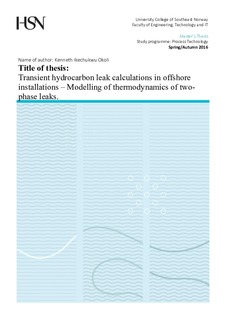| dc.description.abstract | Solutions incorporating the thermodynamic behavior between gas and liquid phases can help in the model development and accurate prediction of transient hydrocarbon leaks.
The system used in this report is a separator. In the industry, safety critical elements like process vessels can trigger large scale hazards if there is a failure in its process containment barrier as a result of leakages in either the gaseous or liquid phases. Thus, there is need to establish and maintain proactively, technical integrity of process vessels so as to prevent the release or mitigate the impact of major accident hazards (MAH) that can harm people, environment, or asset value.
An in-depth literature review of thermodynamics models has been performed in order to compute the model for estimation of hydrocarbon leak rate and depressurization rate of the segment.
A computational leak model was developed and with its coding, the stability and convergence of the model can be assured.
This paper demonstrates that a rigorous dynamic model simulation using a 𝑈𝑉 flash approach can predict accurately hydrocarbon leak rate. | nb_NO |
